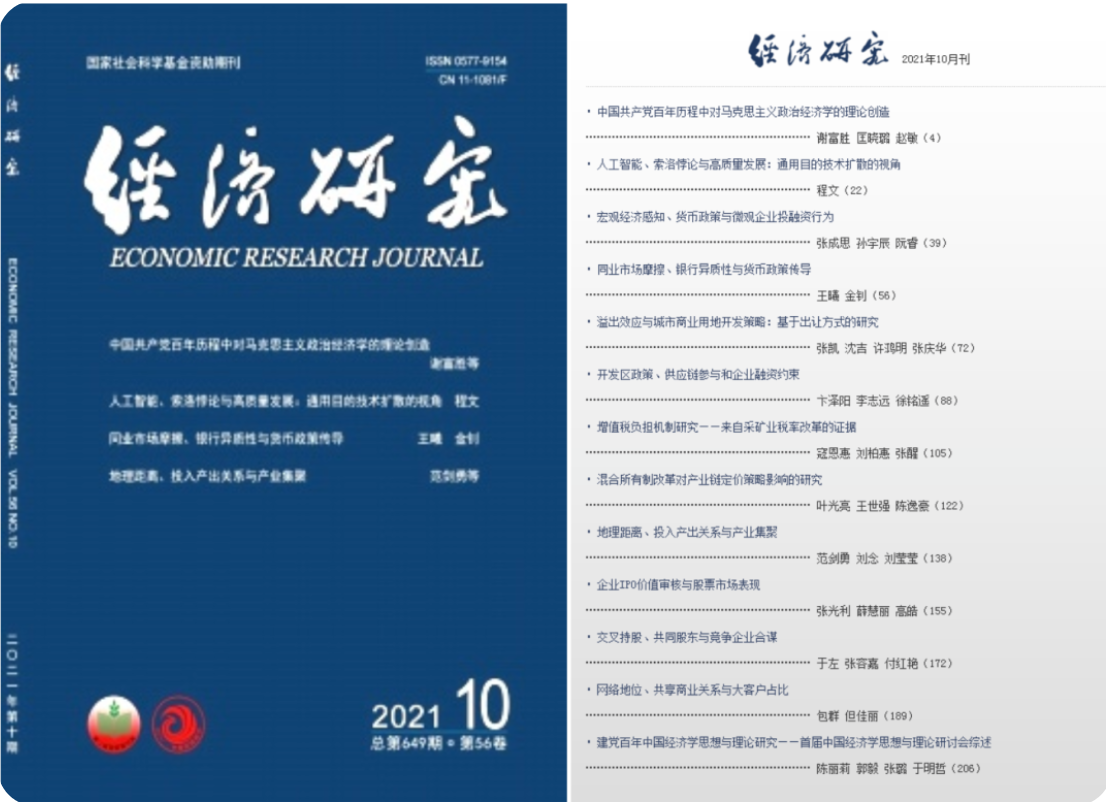岭南观点·30 同业市场摩擦、银行异质性与货币政策传导
王曦教授、金钊博士
我院王曦教授与金钊博士后合作的论文《同业市场摩擦、银行异质性与货币政策传导》作为封面文章于2021年10月在经济学中文顶级期刊《经济研究》发表。

同业市场是货币政策传导的第一环节,稳定的同业市场是我国央行“疏通货币政策传导”的先决条件。但现实是,2007年以来,我国同业市场不稳定性在加剧。
同业拆借双方存在的信息不对称,改变了银行的资产负债管理行为,同业市场摩擦因而导致同业市场不稳定,并弱化了货币政策信贷渠道的传导。此外,我国同业市场中大小银行具有迥异的特征,这与国外明显不同。其中大银行由于历史原因以及政策红利,具有更充裕的流动性与更低的风险偏好。于是在同业市场上,大银行可看作资金批发方,小银行主要是资金拆入方。在同业市场摩擦机制下,大小银行具有不对称的冲击响应,将进一步异化货币政策传导机制。
有鉴于此,本文借鉴前沿同业市场摩擦理论框架,引入符合国情的银行异质性假设,同时引入同业质押市场,构建了不确定性条件下我国商业银行资金运用的动态优化决策模型,深入探讨同业市场摩擦和特殊市场结构对于我国银行贷款投放,以及货币政策信贷传导机制的影响。结论是,信息不对称引发的同业市场摩擦机制阻碍了货币政策传导;面对货币政策冲击,不同类型银行反应不一;异质性银行的特殊市场结构进一步阻碍了货币政策传导——若同业风险飙升,大银行将急剧减少资金拆出规模,货币政策传导遭遇梗阻并产生类“钱荒”现象。同时,本文运用2007-2019年295家商业银行的微观数据进行实证分析,验证了模型的理论推断。
本文首次基于同业市场摩擦以及银行异质性,正式探讨我国银行信贷决策和货币政策传导问题。在学术层面,中国式银行异质性的引入丰富了货币市场与货币政策的相关研究:在微观上,本文可深入理解我国不同种类银行的资产配置与信贷决策行为;同时在宏观上,对于理解我国同业市场运转及货币政策传导,则提供了新视角新架构。
关于疏通我国货币政策传导渠道,本文的政策建议是:①加强监管并强化信息披露,弱化同业市场摩擦机制的影响;②改革现有银行体制和货币政策导向体制,降低银行异质性的影响;③必要时进行更大胆的政策工具创新,构建跨越同业市场的新货币政策传导机制。

Summary
The interbank market is the first link in the transmission of monetary policy. A stable interbank market is a prerequisite for China's central bank to unblock the transmission of monetary policy. However,the reality is that since 2007,the instability of China's interbank market has increased.
It is generally believed that the interbank market frictions are the cause of the instability of the interbank market and the weakening of the credit channel of monetary policy transmission. The information asymmetry between the interbank lending and borrowing parties has changed the bank's asset-liability management behavior. The interbank market frictions therefore affect the monetary policy transmission through bank lending decisions.We also recognize that large and small banks in China's interbank market have very different characteristics,which are significantly different from those abroad.Among them,large banks have more abundant liquidity and lower risk appetite due to historical reasons and policy dividends. Therefore,in the interbank market,large banks can be regarded as fund wholesalers,and small banks are mainly fund borrowers. Under the mechanism of interbank market frictions,large and small banks have asymmetric shock responses,which will further differentiate the monetary policy transmission mechanism.
In this paper,we develop a dynamic equilibrium model that incorporates China's bank heterogeneity to analyze the effectiveness of monetary policy transmission. Our theoretical work builds on the interbank market friction framework of Bianchi & Bigio ( 2017) ,introduces the interbank pledge market at the same time,and discusses the influence of interbank market frictions and special market structure on bank lending and monetary policy credit transmission in China. We find that the mechanism of interbank market frictions caused by information asymmetry hinders the transmission of monetary policy. (1) In the face of monetary policy shocks,different types of banks react differently. (2) The special market structure of heterogeneous banks further hinders the transmission of monetary policy. If interbank risks soar,large banks will sharply reduce the scale of fund lending,and the transmission of monetary policy will be blocked and money shortage will occur.
Our empirical findings are: (1) In the face of tightening monetary policy,banks tend to reduce loans and increase securities assets,that is,a tightening monetary policy still has a certain effect. (2) The greater the interbank market frictions,the greater the buffering effect of securities,and the fewer the loans of small banks. (3) The more the interbank net assets of small banks,the weaker their response to the tightening monetary policy,which is opposite for large banks. (4) The greater the interbank market frictions,the more the interbank net assets of large banks,and the stronger their response to the tightening monetary policy.
Based on the interbank market frictions and bank heterogeneity,this paper is the first to formally discuss the issue of bank credit decision-making and monetary policy transmission in China. At the academic level,the introduction of China's bank heterogeneity has enriched the relevant research on the money market and monetary policy. At the micro level,this paper can deeply understand the asset allocation and credit decision-making behaviors of different types of banks in China, and at the macro level,it provides a new perspective and framework for understanding the operation of China's interbank market and monetary policy transmission.
The extended policy implications are: (1) The central bank needs to strengthen supervision and information disclosure,and weaken the impact of the mechanism of interbank market frictions. (2) The central bank needs to reform the existing banking system and monetary policy orientation system to reduce the impact of bank heterogeneity. (3) The central bank needs to carry out bolder policy instrument innovations,and build a new mechanism of monetary policy transmission that spans the interbank market.

王 曦
广东省珠江学者特聘教授、博士生导师,中山大学中国转型与开放经济研究所所长。研究领域:宏观经济与调控。中国人民银行、国家统计局研究专家/经济学家、《世界经济》编委、中国世界经济学会副秘书长。主持国家自科重点、国家社科重大项目等;获得全国百篇优博、全国高校科研优秀成果奖、安子介奖、省哲社优秀成果奖等。教育部新世纪优秀人才、广东省高层次人才、“广东特支计划”宣传思想文化领军人才。

金 钊
中山大学岭南学院经济学博士,科研博士后。研究领域:货币政策理论与实践、法定数字货币、微观银行学。主持国家自科项目,《经济研究》、《管理世界》等发表论文。



